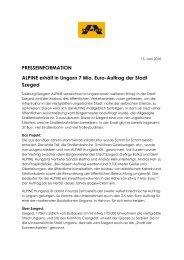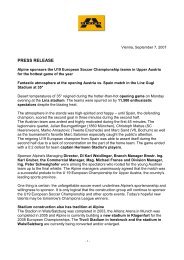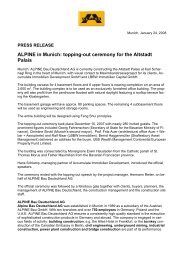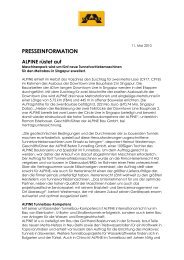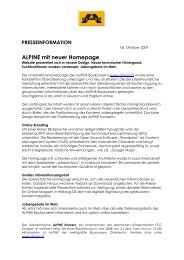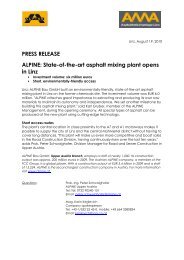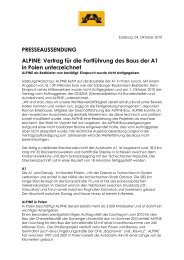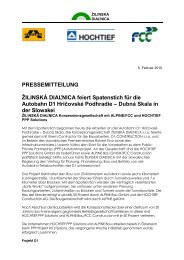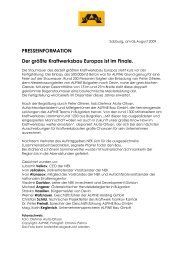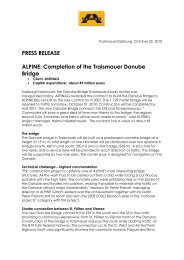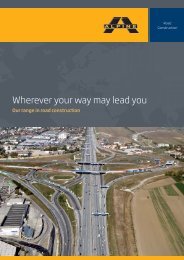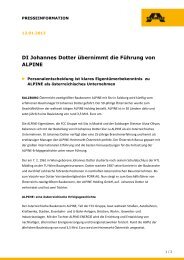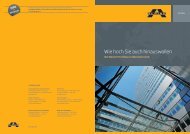Project Y
Project Y
Project Y
You also want an ePaper? Increase the reach of your titles
YUMPU automatically turns print PDFs into web optimized ePapers that Google loves.
dates are increasingly becoming<br />
shorter. The planning phases are<br />
long - and each machine is one of<br />
its kind.<br />
The machine is to leave the factory<br />
as soon as possible as the storage<br />
costs are extremely high. The<br />
machine is almost completely assembled<br />
(95 %) when the customer<br />
performs the factory tests and accepts<br />
the machine. All electro-mechanical<br />
and hydraulic functions<br />
work. The only thing that cannot be<br />
tested is actual drilling. The technical<br />
acceptance is the first hurdle<br />
the manufacturer has to master and<br />
is part of a contractually regulated<br />
procedure. In most cases a contract<br />
is fulfilled only once the tunnel<br />
boring machine arrived at its final<br />
destination, has been completely<br />
assembled and performed the first<br />
few metres of tunnelling.<br />
transPortation is<br />
taken into account in<br />
construction<br />
Construction must already take into<br />
account that the machine will be<br />
assembled, disassembled and reassembled<br />
at its final destination. “30<br />
years of experience play their part in<br />
handling logistics” says Achim Kühn<br />
from the company Herrenknecht<br />
AG in the city of Schwanau (Baden-<br />
Württemberg). About half of all<br />
tunnel boring machines produced<br />
world-wide are manufactured by<br />
this German company.<br />
The logistics part is enormous:<br />
There are about 90,000 individual<br />
parts to a machine. As few components<br />
as possible are disassembled<br />
and the modules are kept as large<br />
as possible for transportation. They<br />
all must arrive at the final destination<br />
according to an exact schedule.<br />
“The hub of it all is project management”<br />
Achim Kühn points out. The<br />
precious goods are protected from<br />
dust and dirt by custom-developed<br />
transportation boxes.<br />
98 % of transportation occur on<br />
water, only 2 % on land. The first<br />
leg from the factory in Schwanau to<br />
the harbour at the city of Kehl (at<br />
the river Rhine) is partially handled<br />
with extra-wide and extra-long<br />
trailers. This is where the parts are<br />
loaded onto ships and shipped via<br />
inland-water-transport routes or<br />
via Rotterdam and the open see.<br />
at the Base of the hiMalaYa<br />
A considerably tougher challenge<br />
is a transportation to India. This is<br />
where ALPINE (as part of a consortium)<br />
constructs an 11.3 km-long<br />
headrace tunnel for a hydropower<br />
station in Tapovan-Vishnugad.<br />
The main bearing of a tunnel boring<br />
machines weighs 85 tons and must<br />
be shipped in two parts as streets<br />
do not allow a weight of more than<br />
60 tons. Not all machine parts must<br />
be shipped to India as the less sensitive<br />
parts are manufactured in India<br />
according to German plans and<br />
subjected to the same tests.<br />
First the containers or transport<br />
boxes arrive at one of the Mumbai<br />
harbours. One harbour only handles<br />
containers and the other only<br />
general cargo. The handling of containers<br />
is faster than that of general<br />
cargo. The goods belonging together<br />
however must be shipped<br />
together despite such differences.<br />
Custom clearance can take between<br />
4 to 6 weeks due to Indian bureaucracy.<br />
“Key to it all is the cooperation<br />
with the right shipper” Paul Bargmann<br />
points out. He is responsible<br />
for the preparation of all machines<br />
necessary for tunnelling.<br />
700 kM in 8 to 10 daYs<br />
Next comes the heavy-load transportation<br />
on the motorway. It takes<br />
from 8 to 10 days to cover the 700<br />
km from Mumbai to Rishikesh at<br />
the base of the mountains. In India<br />
a centre rail, if there at all, serves<br />
only as a rough guideline. Vehicles<br />
and bicycles are tightly packed<br />
on the roads and cows have to be<br />
avoided. The challenge becomes a<br />
real challenge once the base of the<br />
maintains has been reached. The<br />
monsoon may well sweep away a<br />
road or giant rocks may block the<br />
roads that usually are in bad repair<br />
or not solidified at all and soaked.<br />
High humidity may creep into container<br />
and damage machine parts.<br />
Instructing experts and handling<br />
insurance claims is part of the daily<br />
routine once a damage occurred.<br />
There is little space at a tunnel construction<br />
site and all parts must be<br />
delivered in an exact sequence -<br />
as must all material necessary for<br />
construction. A fourwheeler with<br />
a payload of 8 - 10 tons requires<br />
about a day from the storage place<br />
on the plains to the construction<br />
site in about 2,000 m above sea<br />
level. A heavy-goods truck takes<br />
much longer. “Once we even have<br />
lost a container on its way up” Paul<br />
Bargmann tell us. He adds “Once we<br />
had sent a search party we found it in<br />
the middle of the road”. Flat concrete<br />
floors usually exist for the assembly<br />
of a TBM. In this location the work<br />
has to be done on soft and muddy<br />
ground.<br />
However, this cannot unnerve Mr.<br />
Bargmann (in business since 1972)<br />
or his Indian customer. A former<br />
colleague once stated: “We have<br />
deadlines. The Indians have time.” //<br />
Ü www.herrenknecht.de<br />
Ü www.alptransit.ch<br />
29<br />
A tunnelling<br />
construction site<br />
offers very little<br />
space – meeting<br />
exactly defined<br />
delivery schedules<br />
is essential.



